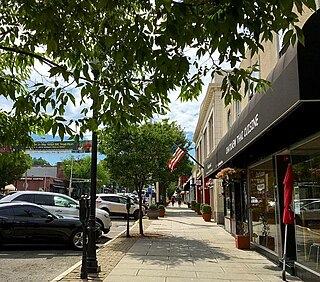The Glass–Steagall legislation describes four provisions of the United States Banking Act of 1933 separating commercial and investment banking. The article 1933 Banking Act describes the entire law, including the legislative history of the provisions covered here.

The Panic of 1893 was a serious economic depression in the United States that began in 1893 and ended in 1897. It deeply affected every sector of the economy, and produced political upheaval that led to the realigning election of 1896 and the presidency of William McKinley.
William Newmarch was an English banker, economist and statistician.
The Independent Treasury was the system for managing the money supply of the United States federal government through the U.S. Treasury and its sub-treasuries, independently of the national banking and financial systems. It was created on August 6, 1846 by the 29th Congress, with the enactment of the Independent Treasury Act of 1846, and it functioned until the early 20th century, when the Federal Reserve System replaced it. During this time, the Treasury took over an ever-larger number of functions of a central bank and the Treasury Department came to be the major force in the U.S. money market.

Charles Arthur Conant was an American journalist, author, and promoter who became recognized as an expert on banking and finance.

Joseph French Johnson was an American economist, journalist, Professor, and Dean of the School of Commerce, Accounts and Finance, New York University, and founding Dean of the Alexander Hamilton Institute in New York in 1909.
William James Rolfe, Litt.D. was an American educator and Shakespearean scholar.
American Banker is a daily trade newspaper and website covering the financial services industry. Founded in 1836 and based in New York, American Banker has approximately 50 reporters and editors in six U.S. cities who monitor developments and breaking news affecting banks.

Frederic Stanley "Rick" Mishkin is an American economist and Alfred Lerner professor of Banking and Financial Institutions at the Graduate School of Business, Columbia University. He was a member of the Board of Governors of the Federal Reserve System from 2006 to 2008.

Sir Robert Harry Inglis Palgrave, FRS, FSS was a British economist.

William Whiting was an American businessman and politician from Holyoke, Massachusetts. Whiting descended from an English family who first settled in Lynn, Massachusetts during 1636.
The British Mycological Society is a learned society established in 1896 to promote the study of fungi.

Charles Bennett Smith was a U.S. Representative from New York.

The Commercial & Financial Chronicle was a business newspaper in the United States founded by William Buck Dana (1829–1910) in 1865. Published weekly, the Commercial & Financial Chronicle was deliberately modeled to be an American take on the popular business newspaper The Economist, which had been founded in England in 1843. It was the first national business weekly in the United States.

Juichi Soyeda was a Japanese lawyer, senior civil servant and academic economist. In 1913 he was delegated by the Tokyo Chamber of Commerce in Japan to study the California Alien Land Law of 1913.
Arthur Germanovich Raffalovich was a Russian financier and economist.

George Evan Roberts was Director of the United States Mint from 1898 to 1907, and again from 1910 to 1914.
Lee Galloway was an American educator, publisher, and organizational theorist. He was Professor in the School of Finance and Commerce at the New York University, and co-founders of The National Association of Corporation Schools, predecessor of the American Management Association.












